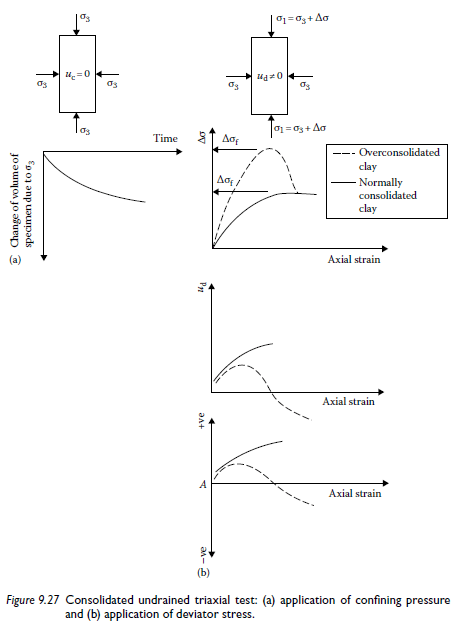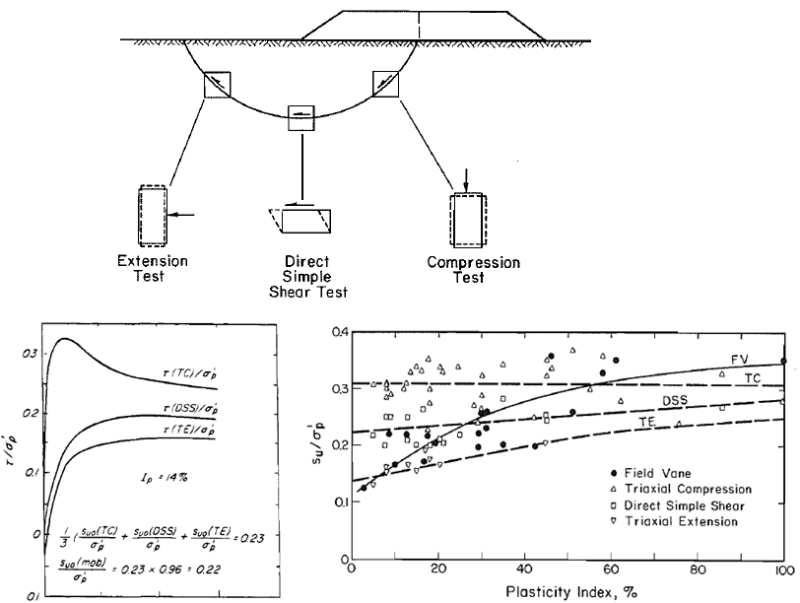Navigation
Install the app
How to install the app on iOS
Follow along with the video below to see how to install our site as a web app on your home screen.
Note: This feature may not be available in some browsers.
More options
Style variation
-
Congratulations TugboatEng on being selected by the Eng-Tips community for having the most helpful posts in the forums last week. Way to Go!
You are using an out of date browser. It may not display this or other websites correctly.
You should upgrade or use an alternative browser.
You should upgrade or use an alternative browser.
Peak Friction Angle
- Thread starter geo24
- Start date
- Status
- Not open for further replies.
the m-c envelope is a way of presenting strength data. The stress-strain relationship is the basis for the strength. You can plot peak, fully softened or residual strength data on m-c plot. How you pick the points from the stress-strain relationships is step 1.
There are also undrained relations, which is a different topic.
The nature of your question is the basis why the ASTM standard for shear strength testing of soil excludes the preparation of the m-c envelope.
f-d
ípapß gordo ainÆt no madre flaca!
There are also undrained relations, which is a different topic.
The nature of your question is the basis why the ASTM standard for shear strength testing of soil excludes the preparation of the m-c envelope.
f-d
ípapß gordo ainÆt no madre flaca!
To determine the peak friction angle in a CU test you would need to first know if there is a peak in your stress strain curve, see image below. I take it from your question you do not have a firm understanding of soil mechanics and you should seek further study to understand which measures of shear strength are applicable in various loading conditions.


to geg: Somewhere strain compatibility has to be considered. If there are three stress ranges and the peak for those is at 4%, 10% and 15% strain, you'd be well advised to question just using peak strengths. This is the reason the M-C is not included in the ASTM Standard for TXC or DDS - just the stress path.
Otherwise, yes, it's the work of an engineer. And, engineers should consider strain compatibility.
f-d
ípapß gordo ainÆt no madre flaca!
Otherwise, yes, it's the work of an engineer. And, engineers should consider strain compatibility.
f-d
ípapß gordo ainÆt no madre flaca!
- Thread starter
- #5
Thanks fattdad and geg!!! I am involved in a project involving slope stability we are using fully softened parameters for analyses. The calculated value of fully softened angles (we are using normal stress and shear stress relationships from work by Duncan, Stark etc.)are less that what we obtained from lab generated CU envelope. So that's what got me thinking about what is the definition of the angle of friction which we get from lab generated CU test Mohrs envelope. Things are getting clarified now, thanks to your replies.
the best way to get FSS is to run a drained direct shear test on normally-consolidated reconstituted sample. Hydrate the clay to the LL and incrementally consolidate the sample to the first normal load, second normal load and third normal load. The peak from that test is the FSS and the residual is the residual.
This is all documented in a CGPR (Center for Geotechnical Practice and Research) publication from 2015 or so. I attended along with Tim Stark, Tom Brandon, Steve Wright, Mike Duncan and many others. (I studied at VT and have been involved with CGPR for quite a spell.)
Nice to see folks getting into these weeds.
f-d
ípapß gordo ainÆt no madre flaca!
This is all documented in a CGPR (Center for Geotechnical Practice and Research) publication from 2015 or so. I attended along with Tim Stark, Tom Brandon, Steve Wright, Mike Duncan and many others. (I studied at VT and have been involved with CGPR for quite a spell.)
Nice to see folks getting into these weeds.
f-d
ípapß gordo ainÆt no madre flaca!
SDUT said:The calculated value of fully softened angles (we are using normal stress and shear stress relationships from work by Duncan, Stark etc.)are less that what we obtained from lab generated CU envelope.
Working in slope stability projects compression tests results are very common to see but understanding the failure plane through a clay layer is typically horizontal the results from direct simple shear testing are more applicable and will show lower shear strengths than compression tests.

- Thread starter
- #8
Thanks very much Gents. This is good stuff.
We have used the direct shear test results on remolded samples before on projects but we did not use that test on the current one. I will go through the CGPR publication that fattdad mentioned.
I read somewhere that undrained strength of clay varies with the orientation of the failure plane. Hence I think the comment from geg. But can we say the same for drained strength. I don't know. can you shed some light?
We have used the direct shear test results on remolded samples before on projects but we did not use that test on the current one. I will go through the CGPR publication that fattdad mentioned.
I read somewhere that undrained strength of clay varies with the orientation of the failure plane. Hence I think the comment from geg. But can we say the same for drained strength. I don't know. can you shed some light?
learn about stress paths. Both the CU (triaxial) and DDS (drained direct shear) test provide strength data. Their stress paths (P-Q relations) are different; however. The, "Best" way to get fully-softened strength is via the DDS, as described by GCPR and my overview above.
The shear surface of the DDS is constrained; however. However; FSS at low normal loads renders this matter trivial.
f-d
ípapß gordo ainÆt no madre flaca!
The shear surface of the DDS is constrained; however. However; FSS at low normal loads renders this matter trivial.
f-d
ípapß gordo ainÆt no madre flaca!
- Thread starter
- #10
Fattdad - do you have a reference for the requirement for strain to be considered? I have only ever looked at peak deviator stress or stress at say 15% strain. I think many tests fail at different strains , not sure how you are supposed to consider that when deriving mc parameters?
Can you explain, please.
Thanks.
Can you explain, please.
Thanks.
When the peak strength for a given confinement varies from one confinement to another, an engineer should consider strain compatibility. Perhaps Bishop and Hinkle describe this? I know that Prof. Duncan made this point in class.
So, if the peak for one load is at 5 percent strain and all the others are at 15 percent strain, the, "Rule" is to strike a line parallel to the initial tangent modulus, but initiate the line at 2 percent strain. That parallel line will strike the stress strain curve at some point. Use that for M-C development.
In this manner, you will solve the strain incompatibility problem. . . and lower your friction angle.
f-d
ípapß gordo ainÆt no madre flaca!
So, if the peak for one load is at 5 percent strain and all the others are at 15 percent strain, the, "Rule" is to strike a line parallel to the initial tangent modulus, but initiate the line at 2 percent strain. That parallel line will strike the stress strain curve at some point. Use that for M-C development.
In this manner, you will solve the strain incompatibility problem. . . and lower your friction angle.
f-d
ípapß gordo ainÆt no madre flaca!
- Status
- Not open for further replies.
Similar threads
- Replies
- 1
- Views
- 202
- Replies
- 7
- Views
- 475
